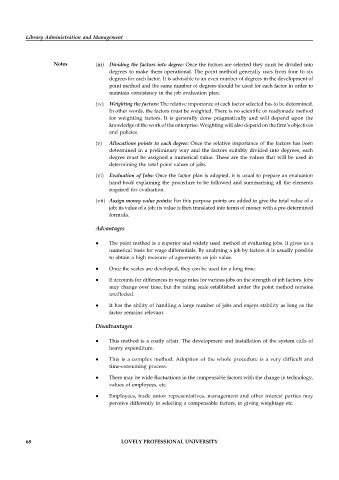Page 73 - DLIS003_LIBRARY ADMINISTRATION AND MANAGEMENT
P. 73
Library Administration and Management
Notes (iii) Dividing the factors into degree: Once the factors are selected they must be divided into
degrees to make them operational. The point method generally uses from four to six
degrees for each factor. It is advisable to an even number of degrees in the development of
point method and the same number of degrees should be used for each factor in order to
maintain consistency in the job evaluation plan.
(iv) Weighting the factors: The relative importance of each factor selected has to be determined.
In other words, the factors must be weighted. There is no scientific or readymade method
for weighting factors. It is generally done pragmatically and will depend upon the
knowledge of the work of the enterprise. Weighting will also depend on the firm’s objectives
and policies.
(v) Allocations points to each degree: Once the relative importance of the factors has been
determined in a preliminary way and the factors suitably divided into degrees, each
degree must be assigned a numerical value. These are the values that will be used in
determining the total point values of jobs.
(vi) Evaluation of Jobs: Once the factor plan is adopted, it is usual to prepare an evaluation
hand-book explaining the procedure to be followed and summarising all the elements
required for evaluation.
(vii) Assign money value points: For this purpose points are added to give the total value of a
job; its value of a job; its value is then translated into terms of money with a pre-determined
formula.
Advantages
The point method is a superior and widely used method of evaluating jobs. It gives us a
numerical basis for wage differentials. By analysing a job by factors it is usually possible
to obtain a high measure of agreements on job value.
Once the scales are developed, they can be used for a long time.
It accounts for differences in wage rates for various jobs on the strength of job factors. Jobs
may change over time, but the rating scale established under the point method remains
unaffected.
It has the ability of handling a large number of jobs and enjoys stability as long as the
factor remains relevant.
Disadvantages
This method is a costly affair. The development and installation of the system calls of
heavy expenditure.
This is a complex method. Adoption of the whole procedure is a very difficult and
time-consuming process.
There may be wide fluctuations in the compensable factors with the change in technology,
values of employees, etc.
Employees, trade union representatives, management and other interest parties may
perceive differently in selecting a compensable factors, in giving weightage etc.
68 LOVELY PROFESSIONAL UNIVERSITY

